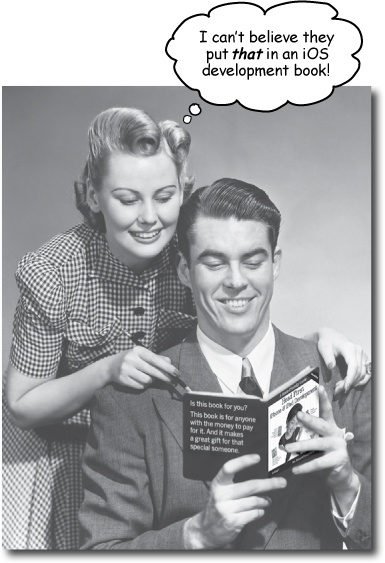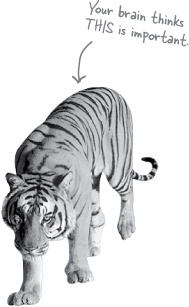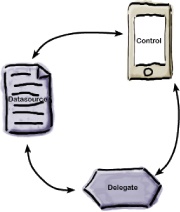If you can answer “yes” to all of these:
Do you have previous development experience?
Do you want to learn, understand, remember, and apply important iOS design and development concepts so that you can write your own iPhone and iPad apps and start selling them in the App Store?
Do you prefer stimulating dinner party conversation to dry, dull, academic lectures?
this book is for you.
If you can answer “yes” to any of these:
Are you completely new to software development?
Are you already developing iOS apps and looking for a reference book on Objective-C?
Are you afraid to try something different? Would you rather have a root canal than mix stripes with plaid? Do you believe that a technical book can’t be serious if there’s a bounty hunter in it?
this book is not for you.
“How can this be a serious iOS development book?”
“What’s with all the graphics?”
“Can I actually learn it this way?”
Your brain craves novelty. It’s always searching, scanning, waiting for something unusual. It was built that way, and it helps you stay alive.
So what does your brain do with all the routine, ordinary, normal things you encounter? Everything it can to stop them from interfering with the brain’s real job—recording things that matter. It doesn’t bother saving the boring things; they never make it past the “this is obviously not important” filter.
How does your brain know what’s important? Suppose you’re out for a day hike and a tiger jumps in front of you. What happens inside your head and body?
Neurons fire. Emotions crank up. Chemicals surge.
And that’s how your brain knows...
This must be important! Don’t forget it!
But imagine you’re at home, or in a library. It’s a safe, warm, tiger-free zone. You’re studying. Getting ready for an exam. Or trying to learn some tough technical topic your boss thinks will take a week, 10 days at the most.
Just one problem. Your brain’s trying to do you a big favor. It’s trying to make sure that this obviously non-important content doesn’t clutter up scarce resources. Resources that are better spent storing the really big things. Like tigers. Like the danger of fire. Like how you should never again snowboard in shorts.
And there’s no simple way to tell your brain, “Hey brain, thank you very much, but no matter how dull this book is, and how little I’m registering on the emotional Richter scale right now, I really do want you to keep this stuff around.”
If you really want to learn, and you want to learn more quickly and more deeply, pay attention to how you pay attention. Think about how you think. Learn how you learn.
Most of us did not take courses on metacognition or learning theory when we were growing up. We were expected to learn, but rarely taught to learn.
But we assume that if you’re holding this book, you really want to learn about iOS development. And you probably don’t want to spend a lot of time. And since you’re going to build more apps in the future, you need to remember what you read. And for that, you’ve got to understand it. To get the most from this book, or any book or learning experience, take responsibility for your brain. Your brain on this content.
The trick is to get your brain to see the new material you’re learning as Really Important. Crucial to your well-being. As important as a tiger. Otherwise, you’re in for a constant battle, with your brain doing its best to keep the new content from sticking.
So just how DO you get your brain to think that iOS development is a hungry tiger?
There’s the slow, tedious way, or the faster, more effective way. The slow way is about sheer repetition. You obviously know that you are able to learn and remember even the dullest of topics if you keep pounding the same thing into your brain. With enough repetition, your brain says, “This doesn’t feel important to him, but he keeps looking at the same thing over and over and over, so I suppose it must be.”
The faster way is to do anything that increases brain activity, especially different types of brain activity. The things on the previous page are a big part of the solution, and they’re all things that have been proven to help your brain work in your favor. For example, studies show that putting words within the pictures they describe (as opposed to somewhere else on the page, like a caption or in the body text) causes your brain to try to makes sense of how the words and picture relate, and this causes more neurons to fire. More neurons firing = more chances for your brain to get that this is something worth paying attention to, and possibly recording.
A conversational style helps because people tend to pay more attention when they perceive that they’re in a conversation, since they’re expected to follow along and hold up their end. The amazing thing is, your brain doesn’t necessarily care that the “conversation” is between you and a book! On the other hand, if the writing style is formal and dry, your brain perceives it the same way you experience being lectured to while sitting in a roomful of passive attendees. No need to stay awake.
But pictures and conversational style are just the beginning.
We used pictures, because your brain is tuned for visuals, not text. As far as your brain’s concerned, a picture really is worth a thousand words. And where text and pictures work together, we embedded the text in the pictures because your brain works more effectively when the text is within the thing the text refers to, as opposed to in a caption or buried in the text somewhere.
We used redundancy, saying the same thing in different ways and with different media types, and multiple senses, to increase the chance that the content gets coded into more than one area of your brain.
We used concepts and pictures in unexpected ways because your brain is tuned for novelty, and we used pictures and ideas with at least some emotional content, because your brain is tuned to pay attention to the biochemistry of emotions. That which causes you to feel something is more likely to be remembered, even if that feeling is nothing more than a little humor, surprise, or interest.
We used a personalized, conversational style, because your brain is tuned to pay more attention when it believes you’re in a conversation than if it thinks you’re passively listening to a presentation. Your brain does this even when you’re reading.
We included loads of activities, because your brain is tuned to learn and remember more when you do things than when you read about things. And we made the exercises challenging-yet-do-able, because that’s what most people prefer.
We used multiple learning styles, because you might prefer step-by-step procedures, while someone else wants to understand the big picture first, and someone else just wants to see an example. But regardless of your own learning preference, everyone benefits from seeing the same content represented in multiple ways.
We include content for both sides of your brain, because the more of your brain you engage, the more likely you are to learn and remember, and the longer you can stay focused. Since working one side of the brain often means giving the other side a chance to rest, you can be more productive at learning for a longer period of time.
And we included stories and exercises that present more than one point of view, because your brain is tuned to learn more deeply when it’s forced to make evaluations and judgments.
We included challenges, with exercises, and asked questions that don’t always have a straight answer, because your brain is tuned to learn and remember when it has to work at something. Think about it—you can’t get your body in shape just by watching people at the gym. But we did our best to make sure that when you’re working hard, it’s on the right things. That you’re not spending one extra dendrite processing a hard-to-understand example, or parsing difficult, jargon-laden, or overly terse text.
We used people. In stories, examples, pictures, etc., because, well, you’re a person. And your brain pays more attention to people than it does to things.
So, we did our part. The rest is up to you. These tips are a starting point; listen to your brain and figure out what works for you and what doesn’t. Try new things.
Slow down. The more you understand, the less you have to memorize.
Don’t just read. Stop and think. When the book asks you a question, don’t just skip to the answer. Imagine that someone really is asking the question. The more deeply you force your brain to think, the better chance you have of learning and remembering.
Do the exercises. Write your own notes.
We put them in, but if we did them for you, that would be like having someone else do your workouts for you. And don’t just look at the exercises. Use a pencil. There’s plenty of evidence that physical activity while learning can increase the learning.
Read the “There Are No Dumb Questions” sections.
That means all of them. They’re not optional sidebars—they’re part of the core content! Don’t skip them.
Make this the last thing you read before bed. Or at least the last challenging thing.
Part of the learning (especially the transfer to long-term memory) happens after you put the book down. Your brain needs time on its own, to do more processing. If you put in something new during that processing time, some of what you just learned will be lost.
Drink water. Lots of it.
Your brain works best in a nice bath of fluid. Dehydration (which can happen before you ever feel thirsty) decreases cognitive function.
Talk about it. Out loud.
Speaking activates a different part of the brain. If you’re trying to understand something, or increase your chance of remembering it later, say it out loud. Better still, try to explain it out loud to someone else. You’ll learn more quickly, and you might uncover ideas you didn’t know were there when you were reading about it.
Listen to your brain.
Pay attention to whether your brain is getting overloaded. If you find yourself starting to skim the surface or forget what you just read, it’s time for a break. Once you go past a certain point, you won’t learn faster by trying to shove more in, and you might even hurt the process.
Feel something!
Your brain needs to know that this matters. Get involved with the stories. Make up your own captions for the photos. Groaning over a bad joke is still better than feeling nothing at all.
Create something!
Apply this to your daily work; use what you’re learning to make decisions on your projects. Just do something to get some experience beyond the exercises and activities in this book. All you need is a pencil and a problem to solve...a problem that might benefit from using the tools and techniques you’re studying for the exam.
This is a learning experience, not a reference book. We deliberately stripped out everything that might get in the way of learning whatever it is we’re working on at that point in the book. And the first time through, you need to begin at the beginning, because the book makes assumptions about what you’ve already seen and learned.
We start off by building an app in the very first chapter.
Believe it or not, even if you’ve never developed for iOS before, you can jump right in and starting building apps. You’ll also learn your way around the tools used for iOS development.
We don’t worry about preparing your app to submit to the App Store until the end of book.
In this book, you can get on with the business of learning how to create iOS apps without stressing over the packaging and distribution of your app out of the gate. But we know that’s what everyone who wants to build an iOS app ultimately wants to do, so we cover that process (and all its glorious gotchas) in an Appendix at the end.
We focus on what you can build and test on the simulator.
The iOS SDK comes with a great (and free!) tool for testing your apps on your computer. The simulator lets you try out your code without having to worry about getting it in the app store or on a real device. But, it also has its limits. There’s some cool iOS stuff you just can’t test on the simulator, like the accelerometer and compass. So, we don’t cover those kinds of things in very much detail in this book since we want to make sure you’re creating and testing apps quickly and easily.
The activities are NOT optional.
The exercises and activities are not add-ons—they’re part of the core content of the book. Some of them are to help with memory, some are for understanding, and some will help you apply what you’ve learned. Don’t skip the exercises. Even crossword puzzles are important—they’ll help get concepts into your brain so they stay there when you’re coding. But more importantly, they’re good for giving your brain a chance to think about the words and terms you’ve been learning in a different context.
The redundancy is intentional and important.
One distinct difference in a Head First book is that we want you to really get it. And we want you to finish the book remembering what you’ve learned. Most reference books don’t have retention and recall as a goal, but this book is about learning, so you’ll see some of the same concepts come up more than once.
The Brain Power exercises don’t have answers.
For some of them, there is no right answer, and for others, part of the learning experience of the Brain Power activities is for you to decide if and when your answers are right. In some of the Brain Power exercises, you will find hints to point you in the right direction.
To develop for the iPhone and iPad, you need an Intel-based Mac, period. We wrote this book using Snow Leopard and Xcode 4.0. If you’re running Leopard with an older version of Xcode, we tried to point out where there were places that would trip you up. For some of the more advanced capabilities, like the accelerometer and the camera, you’ll need an actual iPhone, iPod Touch, or iPad and to be a registered developer. In Chapter 1, we tell you where to get the SDK and Apple documentation, so don’t worry about that for now.
Rich Rosen is one of the co-authors of Mac OS X for Unix Geeks. He also collaborated with Leon Shklar on Web Application Architecture: Principles, Protocols & Practices, a textbook on advanced web application development. He began his career eons ago at Bell Labs, where his work with relational databases, Unix, and the Internet prepared him well for the world of web technology. He lives in New Jersey with his wife, Celia, whose singing provides a sweet counterpoint to the cacophony he produces in his Mac-based home recording studio.
Sean Murphy has been a Cocoa aficionado for almost 10 years, contributes to open source projects such as Camino, and works as an independent iOS designer and developer. He lives in Pennsylvania with his best friends—a fiancÉe, horses, dogs, and cats—and seriously loves hiking, hockey, and nature.
Joe Heck is a software developer, technology manager, author, and instructor who’s been involved with computing for 25 years and developing for the iPhone platform since the first beta release. He’s the founder of the Seattle Xcoders developer group, which supports Macintosh and iPhone development in the Seattle area, and the author of SeattleBus, an iPhone app that provides real-time arrival and departure times of Seattle public transportation (available on the App Store).
Eric Shepherd got started programming at age nine and never looked back. He’s been a technical writer, writing developer documentation since 1997, and is currently the developer documentation lead at Mozilla. In his spare time, he writes software for old Apple II computers—because his day job just isn’t geeky enough—and spends time with his daughter. His thorough review means that no one else has to go through the problems he had in actually making the code work.
Michael Morrison is a writer, developer, and author of Head First JavaScript, Head First PHP & MySQL, and even a few books that don’t have squiggly arrows, stick figures, and magnets. Michael is the founder of Stalefish Labs (www.stalefishlabs.com), an edutainment company specializing in games, toys, and interactive media, including a few iPhone apps. Michael spends a lot of time wearing helmets, be it for skateboarding, hockey, or iPhone debugging. Since he has iPhone Head First experience, Mike was a great resource to have helping us.
Our editors:
Thanks to Courtney Nash, who has turned into not just our editor, but general all-around O’Reilly handler. She has listened to lots of rants, spent a week on camera with Dan, and still managed to carry us through two updates to the book, one that didn’t get published! She has had her hand in every single one of the over 600 pages in the book and it’s better because of her involvement.
And to Brett McLaughlin, who kicked off the first edition of this book by responding to an IM that said, “What do you think about Head First iPhone?” and trained us both up in the ways of Head First.
The O’Reilly team:
To Karen Shaner, who, as always, kept things running smoothly, which is helpful when we keep changing things. And to Laurie Petrycki, who continues to let us write more Head First books, which apparently is habit forming.
Our friends and family:
To all the Pilones and Chadwicks, who have always been supportive of our efforts and helped us to become grown ups who can write this stuff. To all our friends at Element 84, who have made this book part of our company and helped us create a place where we enjoy working. And to Paul, who in addition to kicking off this Apple thing by bringing Macs into our house years ago, was employee #1 at Element 84 and a proofreader of this book.
To Vinny and Nick, who think that everybody’s parents work together, thank you for putting up with us constantly talking about iOS development. We’re hoping they’re going to be ready to intern this summer.
Finally, to Apple, as silly as it sounds, because iOS development has been good to us! We thought the iPhone was great, but the iPad has already changed how we read and interact with the Web. We’re looking forward to being a part of that change.
Safari® Books Online is an on-demand digital library that lets you easily search over 7,500 technology and creative reference books and videos to find the answers you need quickly.
With a subscription, you can read any page and watch any video from our library online. Read books on your cell phone and mobile devices. Access new titles before they are available for print, and get exclusive access to manuscripts in development and post feedback for the authors. Copy and paste code samples, organize your favorites, download chapters, bookmark key sections, create notes, print out pages, and benefit from tons of other time-saving features.
O’Reilly Media has uploaded this book to the Safari Books Online service. To have full digital access to this book and others on similar topics from O’Reilly and other publishers, sign up for free at http://my.safaribooksonline.com.
Get Head First iPhone and iPad Development, 2nd Edition now with the O’Reilly learning platform.
O’Reilly members experience books, live events, courses curated by job role, and more from O’Reilly and nearly 200 top publishers.





















